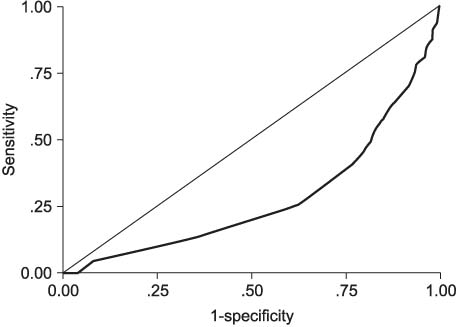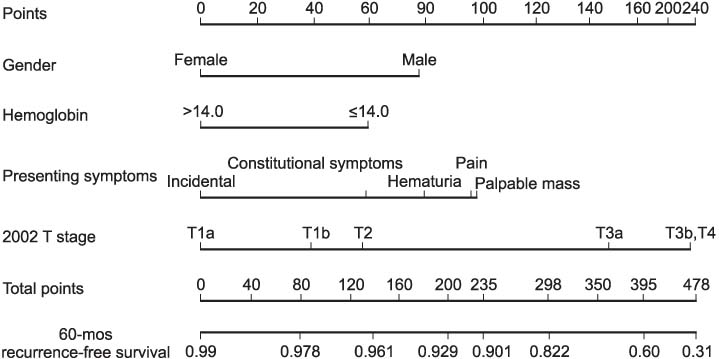Korean J Urol.
2006 Sep;47(9):963-967. 10.4111/kju.2006.47.9.963.
Korean Nomogram for the Prediction of Recurrence-free Survival after Definitive Surgery for Renal Cell Carcinoma
- Affiliations
-
- 1Department of Urology, University of Ulsan, Korea. cskim@amc.seoul.kr
- 2Department of Preventive Medicine, University of Ulsan, Korea.
- 3Department of Urology, Gachon Medical School, Korea.
- 4Department of Urology, The Catholic University of Korea, Korea.
- 5Department of Urology, Kyungpook National University, Korea.
- 6Department of Urology, Kyung Hee University, Korea.
- 7Department of Urology, Keimyung University, Korea.
- 8Department of Urology, Korea University, Korea.
- 9Department of Urology, Dongguk University, Korea.
- 10Department of Urology, Dong-A University, Korea.
- 11Department of Urology, Pusan National University, Korea.
- 12Department of Urology, Sungkyunkwan University, Korea.
- 13Department of Urology, Ajou University, Korea.
- 14Department of Urology, Yonsei University, Korea.
- 15Department of Urology, Inje University, Korea.
- 16Department of Urology, Inha University, Korea.
- 17Department of Urology, Hallym University, Korea.
- 18Department of Urology, Chonbuk University, Korea.
- 19Department of Urology, Chungnam National University, Korea.
- 20Department of Urology, Chungbuk University, Korea.
- 21Department of Urology, Chonnam National University, Korea.
- KMID: 2294092
- DOI: http://doi.org/10.4111/kju.2006.47.9.963
Abstract
- Purpose
This multiinstitutional study was to investigate the accuracy of the Kattan nomograms for the prediction of recurrence after definitive surgery for renal cell carcinoma (RCC) in Korean patients and develop a nomogram revised to complement the shortcomings.
Materials and Methods
Clinical and pathological data of 1,866 patients with RCC who had been followed for at least 2 years after surgery in each participating institutes were reviewed as well as evidence of disease recurrence, defined to include local recurrence and distant metastasis. Accuracy of the Kattan nomograms' predictability in tumors 7cm or less was tested by calculating the area under the receiver-operating characteristics curve (AUC) and actuarial recurrence-free survival by Kaplan- Meier method. We used the Cox proportional hazard analysis to identify significant variables and develop prediction nomogram, and internally validated by bootstrapping method. Mean follow-up was 56.5 months (24-184).
Results
Recurrence occurred in 12.5% of the patients and correlated with the pathological stage, with 4.3%, 7.9%, 15.0%, 22.6%, 38.4%, 58.3% for stages T1a, T1b, T2, T3a, T3b/c and T4, respectively (p<0.001). The AUC of the Kattan nomograms was 0.276. Factors significantly predictive of recurrence were T stage (p<0.0001), presentation (p=0.006), preoperative hemoglobin (p=0.023) and gender (p=0.032). Actuarial 60-month recurrence- free survival was 87.9% and using the prognostic factors, nomogram predicting 60-month recurrence-free survival was constructed.
Conclusions
Korean nomogram complementing the preexisting nomograms for the prediction of recurrence-free survival after definitive surgery for RCC has been constructed, which may be useful in patient prognostication, counseling and follow-up planning.
Keyword
MeSH Terms
Figure
Reference
-
1. Ministry of Health and Welfare. 2002 Annual Report of the Korea Central Cancer Registry. (Published in 2003).2. Kattan MW, Reuter V, Motzer RJ, Katz J, Russo P. A postoperative prognostic nomogram for renal cell carcinoma. J Urol. 2001. 166:63–67.3. Zisman A, Pantuck AJ, Wieder J, Chao DH, Dorey F, Said JW, et al. Risk group assessment and clinical outcome algorithm to predict the natural history of patients with surgically resected renal cell carcinoma. J Clin Oncol. 2002. 20:4559–4566.4. Leibovich BC, Blute ML, Cheville JC, Lohse CM, Frank I, Kwon ED, et al. Prediction of progression after radical nephrectomy for patients with clear cell renal cell carcinoma: a stratification tool for prospective clinical trials. Cancer. 2003. 97:1663–1671.5. Elson PJ, Witte RS, Trump DL. Prognostic factors for survival in patients with recurrent or metastatic renal cell carcinoma. Cancer Res. 1988. 48:7310–7313.6. Sorbellini M, Kattan MW, Snyder ME, Reuter V, Motzer R, Goetzl M, et al. A postoperative prognostic nomogram predicting recurrence for patients with conventional clear cell renal cell carcinoma. J Urol. 2005. 173:48–51.7. Yi JW, Kim YJ, Kim YW, Chang SG. The prognostic factors influencing the survival rate in patients with localized renal cell carcinoma. Korean J Urol. 2004. 45:872–877.8. Kim DS, Woo YN, Lee TY. The value of tumor size as a prognostic factor in patients with localized renal cell carcinomas. Korean J Urol. 2002. 43:813–817.9. Kim SW, Park WJ, Ha JS, Lee SJ, Lee JY, Lee CB, et al. Prognostic factors in renal cell carcinoma. Korean J Urol. 2002. 43:98–105.10. Kovacs G, Akhtar M, Beckwith BJ, Bugert P, Cooper CS, Delahunt B, et al. The Heidelberg classification of renal cell tumours. J Pathol. 1997. 183:131–133.11. Green FL, Page DL, Fleming ID, Fritz A, Balch CM, Haller DG, et al. AJCC cancer staging manual. 2002. 6th ed. New York: Springer-Verlag;323–328.12. Elmore JM, Kadesky KT, Koeneman KS, Sagalowsky AI. Reassessment of the 1997 TNM classification system for renal cell carcinoma. Cancer. 2003. 98:2329–2334.13. Atzpodien J, Royston P, Wandert T, Reitz M. Metastatic renal carcinoma comprehensive prognostic system. Br J Cancer. 2003. 88:348–353.14. Onishi T, Oishi Y, Goto H, Yanada S, Abe K. Gender as a prognostic factor in patients with renal cell carcinoma. BJU Int. 2002. 90:32–36.15. Beisland C, Medby PC, Beisland HO. Renal cell carcinoma: gender difference in incidental detection and cancer-specific survival. Scand J Urol Nephrol. 2002. 36:414–418.16. Langner C, Ratschek M, Rehak P, Schips L, Zigeuner R. Steroid hormone receptor expression in renal cell carcinoma: an immunohistochemical analysis of 182 tumors. J Urol. 2004. 171:611–614.
- Full Text Links
- Actions
-
Cited
- CITED
-
- Close
- Share
- Similar articles
-
- Nomogram for Predicting Survival for Oral Squamous Cell Carcinoma
- Comparison of Prognosis in Types 1 and 2 Papillary Renal Cell Carcinoma and Clear Cell Renal Cell Carcinoma in T1 Stage
- Establishment and Validation of a Nomogram for Nasopharyngeal Carcinoma Patients Concerning the Prognostic Effect of Parotid Lymph Node Metastases
- Prognostic Evaluation and Survival Prediction for Combined Hepatocellular-Cholangiocarcinoma Following Hepatectomy
- Comparison of the Clinical Outcomes of Esophagectomy and Concurrent Chemoradiotherapy in Patients with Locally Advanced Esophageal Squamous Cell Carcinoma



